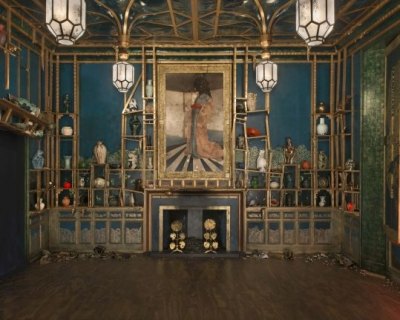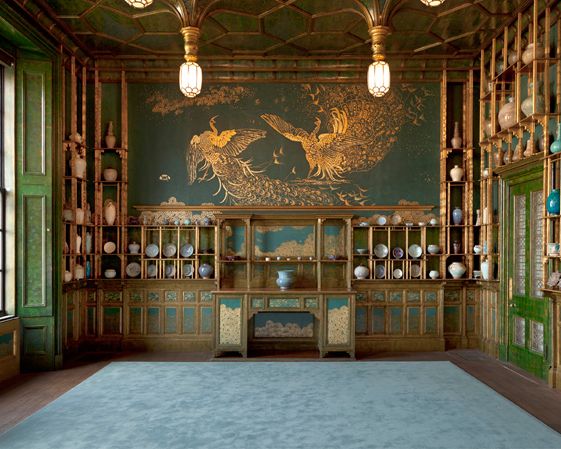Smithsonian gallery drips "Filthy Lucre"

It is called Peacock Room Remix: Darren Waterston’s Filthy Lucre, at the Arthur M. Sackler Gallery. On view until Jan. 2, 2017, Waterston's exhibit offers a thought-provoking take on a famous interior design, James McNeill Whistler’s Peacock Room. Here is the rundown:
The background: Born in 1834 in Lowell, Massachusetts, Whistler spent some of his childhood in St. Petersburg, Russia. His father, a civil engineer, had a job there, according to the website for the Metropolitan Museum of Art in New York City. In Russia, he studied art at the Imperial Academy of Sciences. When the family returned home, he enrolled at West Point, only to be dismissed in 1854 after failing chemistry.
Moving to Paris, Whistler studied painting. By the early 1860s, he moved between Paris and London, eventually settling in London in 1863. Significantly, he befriended the family of Frederick Leyland (1831-1892) a shipping mogul and arts patron.

The history of the Peacock Room: In 1876, Leyland redecorated the dining room of his London home. An interior architect, Thomas Jeckyll, was hired to do the work and built shelves to display Leyland’s collection of Chinese porcelain. One of Whistler’s paintings, The Princess from the Land of Porcelain, hung over the fireplace. As the story goes, Jeckyll asked Whistler’s opinion about which color should be used to paint the dining room shutters and doors.
Trouble begins: Whistler was concerned that some of the room’s colors clashed with the color scheme in The Princess from the Land of Porcelain, and he volunteered to retouch the walls with “traces of yellow,” according to the Smithsonian. This sounded fine to Leyland, who agreed that Whistler could make minor alterations.
When Leyland went away for the summer, Whistler took it upon himself to expand the project. A pattern of peacock feathers covered the ceiling. The wooden shelves were painted gold. Golden peacocks adorned the shutters. (To visit the original Peacock Room, reinstalled decades later at the Smithsonian's Freer Gallery of Art, is to feel as though you have stepped inside a painting.)
Pleased with himself, Whistler invited friends and even the press to take a look at the room, while encouraging Leyland to stay away until the project was completed.
The falling out: Leyland wasn’t amused. To begin with, he hadn’t asked for all that, and Whistler’s bill was a whopping 2,000 guineas --$200,000 today, according to Smithsonian magazine. Leyland eventually agreed to pay half the amount. Whistler then finished his work on the room with a vengeance. On the wall opposite his Princess from the Land of Porcelain painting, he painted two peacocks, squabbling over a nest of money. He also completed a painting of Leyland, The Gold Scab: Eruption in Frilthy Lucre. The word "Frilthy" was apparently word play -- Leyland wore frilly shirts and his initials were F.L. The painting shows him as half man, half peacock and again, dripping money.
What happened to the room? Despite the quarrel, Leyland knew better than to destroy the room or have it repainted. He even continued to eat in the room, according to the Smithsonian. After Leyland died in 1892, the Peacock Room was subsequently purchased by Charles Lang Freer, an American who had become rich in the railroad car manufacturing industry and had a taste for art. After reinstalling the room in his Detroit mansion, Freer used it to display his own collection of pottery. He subsequently donated his collection of Asian and American art to the nation.
So what is the current exhibition all about? Much like the original Peacock Room, the Peacock Room Remix, Darren Waterston’s Filthy Lucre, takes visitors inside the room – but it is in ruins and dimly lit. Gold paint is pooled on the floor. Broken shards of pottery are scattered about the walls. The shelving is crumpling. The visitor has walked into another painting about the trying relationships between artists and patrons -- or art and money.
The exhibition will have an 18-month run. It features a video presentation that gives the history of the Peacock Room, including the scathing letters exchanged by Leyland and Whistler. In conjunction with the exhibition, there will be separate installations, the first featuring Whistler's portraits of the Leyland family, according to the Smithsonian.
Recommended:
The Smithsonian Institution's Freer-Sackler website: Peacock Room Remix
Univeristy of Glasgow: The correspondence of James McNeill Whistler.
Smithsonian.edu: A closer look, exhibitions – The Peacock Room
Smithsonian.com: The story behind the Peacock Room’s princess
Encyclopedia Britannica: James McNeill Whistler
Metropolitan Museum of Art: James McNeill Whistler, 1834-1903
Smithsonian.edu: Whistler’s Peacock Room
Related:
25 things to see as the Smithsonian's National Museum of American History turns 50
If you would like to comment, contact StudyHall.Rocks or like us on Facebook and tell us what you think.

